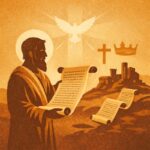| Host: | Mathilde Frey |
|---|---|
| Guests: | Alex Bryan and Andreas Beccai |
| Quarter: | Themes in the Gospel of John |
| Lesson: | 2 |
| Sabbath: | October 12th, 2024 |
Relevant Verses: John 6:1–15, 26–36; 11
Theme: Signs of Divinity
Leading Question: What persuades you about Jesus as a divine being?
Nowhere in the New Testament is Jesus presented as more thoroughly human and more thoroughly divine than in the Gospel of John. Consider these polarities pointed out by Prof. Paul N. Anderson, The Riddles of the Fourth Gospel (p. 26-27):
On one hand, Jesus’ divinity is pronounced in John:
- The glory of Jesus is testified to from the beginning of the Gospel (1:4; 2:11; 11:4; 14:13; 17:1) and his “glorification” is emphasized extensively (1:51; 3:14; 6:62; 8:28; 12:23, 34; 13:1)
- Jesus is equated with God in John 1:1-2 MS 18 and is called “my Lord and my God” by Thomas in John 20:28. Likewise, the “I AM” of Exodus 3:14 is used to point to Jesus in John 8:58—a perceivedly blasphemous claim (see v. 59)—and Jesus’ appearance on the lake is presented as a theophany (6:20).
- Further, the divine certainty and sway of Jesus are featured (1:47-51; 2:24-25; 4:17-19; 5:41-42; 6:64; 13:1-3): Jesus knows full well what he will do and what is going to happen to him (6:6; 13:1, 3; 16:19, 30; 18:4; 19:28); his adversaries cannot arrest him unless his time has arrived (7:30; 8:20); and people experience themselves as being “known by the divine” in their encounters with Jesus (1:48; 4:19, 39; 5:6; 9:38; 10:4, 14, 27; 20:16; 21:7).
- Jesus is presented as God striding over the earth in John.
On the other hand, Jesus’ humanity is unmistakable:
- The incarnational “flesh” of Jesus is insisted upon in John (1:14; 6:51, 53-56), and his humanity is acknowledged by others (1:45; 10:33; 18:5-7).
- His human family references are clear (1:45; 2:1-12; 6:42; 19:19, 25-27), and not even his brothers believed in him (7:5).
- Out of his side flow physical blood and water (19:34), and Thomas is allowed to touch Jesus’ flesh wounds with his finger and hand (20:27). Further, Jesus weeps at Lazarus’ tomb (11:35); his heart is deeply troubled (11:33; 12:27; 13:21); he groans (11:33, 38); on the cross he thirsts (19:28); and he loves his own (11:3, 5, 36; 13:1, 23, 34; 14:21; 15:9-12).
- The fleshly, pathos-filled Jesus is also a reality in the Johannine text.
Question: Do we need the miraculous signs to convince us of Christ’s divinity? What is it that convinces you that Jesus is divine?
Question: Are John’s signs proof of Jesus’ divinity or is there something more that John wants to tell us?
See: Jesus as the “I AM” — Jesus in the Present Tense
Question: What Is the significance of Jesus’ “I Am” Statements?
“I am the bread of life” (John 6:35, 48)
Jesus spoke this shortly after feeding the five thousand, and the crowds demanded more free food. But Jesus did not want to continue satisfying their appetites. He wanted them to understand that physical food only temporarily filled hunger, whereas He was the only One who could fulfill them spiritually. He was explaining that He is the bread of life. Manna met the Israelites’ physical necessities in the wilderness, but only for a while. Christ will satisfy our spiritual wants forever. People who believe in Jesus have life. Manna in the wilderness provided temporary sustenance, but those who ate it eventually died. Jesus offers the bread of life, which leads to eternal life.
“I am the light of the world” (John 8:12)
Jesus made this statement at the Feast of Tabernacles. At this feast, a massive candelabra was lit in the temple’s women’s courtyard. It reminded the Israelites of the pillar of fire that guided their ancestors through the wilderness. Jesus made this comment shortly after forgiving, rather than condemning, a woman who was accused of being caught in adultery.
“I am the door” (John 10:7, 9)
Jesus said this during a conversation with the religious readers, in which he condemned them to be unsuitable shepherds. Shepherds led their flocks into stone enclosures every night to protect them. These constructions had no doors. To avoid predator attacks, the shepherd would sit or sleep in the opening. Thus, Jesus described His care and unwavering love to those who are His. This comment also confirms what He said in John 14:6 about being the only way to reach the Father. The only way to enter God’s “sheepfold” or “family” is through Jesus – the door or gateway.
“I am the good shepherd” (John 10:11, 14)
This statement described Jesus’ selfless love for His people. Unlike a hired man who will flee and leave a flock unprotected to save his own life when a wolf approaches the sheep, He will not desert His sheep but will maintain watch over them. In John 10:15-16, Jesus stated, “I lay down My life for the sheep.” In Psalm 23, David called the Lord God his shepherd, and in John 10, Jesus refers to Himself as the ultimate Good Shepherd, about to give His life for His sheep.
“I am the resurrection and the life” (John 11:25)
Following the death of Martha’s brother, Lazarus, Jesus spoke words of hope to her. In the following verse, He reinforced His declaration, “And whoever lives and believes in Me will never die. Do you believe this?” (John 11:26). Death evoked feelings of despair, hopelessness, and finality until Jesus spoke those magnificent words and demonstrated them by resurrecting His deceased friend. According to 1 Corinthians 15:55, death no longer has a sting since Jesus has defeated the grave.
“I am the way, the truth, and the life” (John 14:6)
When the disciples were perplexed by Jesus’ remarks about heaven, Thomas asked: “Lord, we do not know where You are going, and how can we know the way?” Jesus told him, “I am the way, the truth, and the life. No one comes to the Father except through Me” (John 14:5, 6). Jesus describes here his departure and promise to send the Spirit to take his place. The disciples can trust his promise that he will not leave them alone, for he is “the way, and the truth, and the life.
“I am the true vine” (John 15:1, 5)
The imagery of the vine follows after the call, “do as the Father commanded me” (14:31). The commandment is first about bearing fruit but at the same time the image of the vine offers a picture by which the disciples may see themselves as able to do as commanded because of their connection to the vine. The image is first a description of Jesus’ relationship with the Father, and only after that a picture by which the disciples may see their relationship with Jesus. This is key in the mutual abiding between Jesus, the Father, and the disciples.
Question: Why are these bold statements important?
Even though the Gospel of John ascribes to Jesus full equality with God, it also contains the theme of voluntary subordination. Jesus is dependent on God for his message (7:16; 14:24), his life (5:26; 6:27), his power (5:30), his authority to execute judgment and give life (5:21-29), his disciples (6:37, 44), and his glory (17:1).





